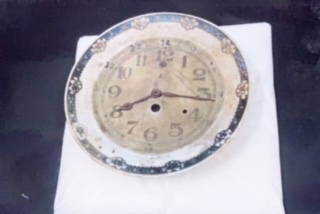Tokuso Hamai
Lost lives never come back
6. Dish Clock


My uncle who had raised me passed away in September, 1998. I felt completely lonely by his death, because I lost all my blood-related people. When I went to the city center, I used to drop by the Merciful Goddess of Peace (Nakajima-honmachi Townspeople Monument.) After my uncle died, I visited the Hiroshima Peace Memorial Museum. There was a notebook for visitors at the exit, and I wrote about the dish clock which my uncle brought from our house the day after the A-bombing. After I wiped soot and dust away, it became beautiful, the same as it used to be. I put it on the wall for a while after the A-bombing, where it reminded me of my happy childhood. But it was also painful to remember those days, so, I put it in the closet. It remained there even after I left my uncle’s house.
This German-made dish clock was originally on the wall between the two mirrors at my father’s shop. It was my duty to wind it up before I went to school. During the war, the municipal office said that since there was a half day time difference between Japan and the U.S.A., we had to fight for 24 hours. They gave us the paper with the numbers 13-24 written on it, and I cut the paper and glued those pieces of paper above numbers 1-12. The glue was made from boiled rice.
Several days after I wrote about the clock in the notebook at the Museum, I got a phone call from the staff. They asked me to show them the clock. I took the clock, along with some melted stones which I had picked up in Nakajima-honmachi and donated them to the Museum. At that time, I heard that they had ten clocks, all stopped at 8:15. Now, there are 70 clocks. Later in 2001, the clock was displayed during the exhibition “Reviving Memories of History: The Town at the Hypocenter Vanished Instantly,” which was held in the Hiroshima Peace Memorial Museum.
From July 28, 1991, the local Chugoku Shimbun newspaper published an 8-part series, “Memories of Nakajima-honmachi.” Part 4 was about me, “Uncle Helps Boy Follow in His Father’s Footsteps as a Barber.” As I didn’t want to talk about those hard-time stories, I had never talked about the A-bombing. However, another article about me, “This Person,” was published in 2018 and there was a big response. There were some people who wanted me to talk about my experience of A-bombing, and at the same time, some people pressured me to say nothing. Despite their pressure, I started talking about my experience in 2003.

